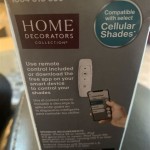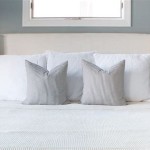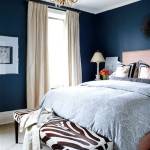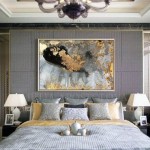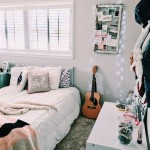Decorating A Bedroom With Yellow Walls
Yellow, often associated with sunshine, happiness, and optimism, can be a vibrant and uplifting choice for bedroom walls. However, decorating a bedroom with yellow walls requires careful consideration to avoid overwhelming the space and ensure a restful and aesthetically pleasing environment. The key lies in understanding the nuances of yellow hues, balancing them with complementary colors, and strategically incorporating furniture and accessories to create a cohesive and harmonious design.
The psychology of color plays a significant role in influencing mood and emotions. Yellow, in particular, can stimulate creativity and energy but can also be overwhelming in large doses. Therefore, the choice of yellow shade is paramount. A pale, buttery yellow can create a soft and calming atmosphere, while a brighter, more saturated yellow can inject energy and vibrancy. It's advisable to test different shades of yellow in the specific bedroom to observe how they appear under different lighting conditions throughout the day. Natural light, artificial light, and even the direction the room faces can all impact how the yellow paint reads on the walls.
Once the ideal shade of yellow has been selected, the next step involves choosing complementary colors to create balance and visual interest. Neutral colors such as white, gray, and beige are excellent choices for grounding the yellow and preventing the room from feeling too intense. These neutral tones can be incorporated through bedding, furniture, and rugs. Alternatively, incorporating deeper, contrasting colors like navy blue, charcoal gray, or even a muted green can create a sophisticated and visually striking contrast against the yellow backdrop. The key is to maintain a balance, ensuring that no single color overwhelms the others.
The style of the bedroom should also influence the design choices. A modern bedroom might benefit from clean lines, minimalist furniture, and pops of bold, contrasting colors against the yellow walls. A traditional bedroom, on the other hand, could embrace softer, more muted tones and incorporate classic furniture pieces with ornate details. A bohemian-inspired bedroom might feature a mix of textures, patterns, and eclectic accessories, creating a more relaxed and unconventional atmosphere.
Lighting plays a crucial role in how any color is perceived, and yellow is no exception. Adequate lighting is essential to prevent the room from feeling dim or gloomy. A combination of natural light and artificial lighting is ideal. Maximize natural light by using sheer curtains or blinds that allow sunlight to filter through. Incorporate a variety of artificial light sources, including overhead lighting, task lighting (such as bedside lamps for reading), and ambient lighting (such as floor lamps or wall sconces) to create a warm and inviting atmosphere. The type of light bulb used can also affect the appearance of the yellow walls; warm-toned bulbs will enhance the yellow hues, while cool-toned bulbs can create a more neutral effect.
Key Point 1: Selecting the Right Shade of Yellow
The success of a yellow bedroom hinges on choosing the right shade of yellow for the space. The spectrum of yellow is vast, ranging from soft, pastel yellows reminiscent of vanilla ice cream to bold, citrusy yellows that evoke the feeling of sunshine. Before committing to a specific shade, it is crucial to consider the size of the room, the amount of natural light it receives, and the desired ambiance. For smaller bedrooms, lighter, more muted yellows tend to work best, as they can help to make the room feel brighter and more spacious. Brighter, more saturated yellows can be used as accent colors or in larger bedrooms where they will not feel overwhelming.
Sampling paint colors is a crucial step in the selection process. Paint a small area of the wall with each potential shade and observe how the color appears at different times of the day and under different lighting conditions. Consider the undertones of the yellow; some yellows have warm, orange undertones, while others have cooler, greenish undertones. Choose a shade that complements the existing furniture and accessories, or plan to update these items to coordinate with the chosen yellow.
Furthermore, it is important to consider the overall style of the bedroom when selecting a shade of yellow. A more traditional bedroom might benefit from a softer, more muted yellow, while a modern bedroom could handle a bolder, more vibrant shade. Ultimately, the best shade of yellow is one that evokes the desired mood and complements the overall design aesthetic.
Key Point 2: Balancing Yellow with Complementary Colors
While yellow can be a beautiful and uplifting color on its own, it is often best paired with complementary colors to create a balanced and harmonious space. The choice of complementary colors will depend on the specific shade of yellow used and the desired overall effect. Neutral colors, such as white, gray, and beige, are always a safe bet, as they can help to ground the yellow and prevent it from feeling overwhelming. These neutral tones can be incorporated through bedding, furniture, rugs, and window treatments.
For a more dramatic effect, consider using contrasting colors, such as navy blue, charcoal gray, or even a muted green. These colors can create a visually striking contrast against the yellow walls, adding depth and interest to the room. When using contrasting colors, it is important to maintain a balance, ensuring that no single color overwhelms the others. A good rule of thumb is to use yellow as the dominant color, with the contrasting color used as an accent.
Another approach is to use different shades of yellow to create a monochromatic color scheme. This can be a subtle and sophisticated way to add depth and interest to the room without introducing too many competing colors. For example, a bedroom with pale yellow walls could incorporate furniture and accessories in deeper shades of yellow, such as mustard or gold.
The incorporation of natural materials, such as wood, rattan, and woven textiles, can also help to balance the brightness of yellow and create a more grounded and organic feel. These materials add texture and warmth to the space, complementing the yellow walls and creating a sense of comfort and relaxation.
Key Point 3: Strategic Furniture and Accessory Choices
The furniture and accessories chosen for a yellow bedroom play a crucial role in creating a cohesive and aesthetically pleasing space. The style, color, and texture of these items should complement the yellow walls and contribute to the overall design aesthetic. When selecting furniture, consider the size of the room and the desired functionality. In smaller bedrooms, opt for lighter, more streamlined furniture pieces to avoid overwhelming the space. In larger bedrooms, more substantial pieces can be used to create a sense of grandeur and presence.
The color of the furniture should also be carefully considered. White furniture can create a clean and airy feel against yellow walls, while dark wood furniture can add warmth and richness. Upholstered furniture in neutral colors, such as gray, beige, or cream, can provide a comfortable and versatile backdrop for pops of color in the accessories. If opting for colorful furniture, choose shades that complement the yellow walls, such as blue, green, or orange.
Accessories are an excellent way to add personality and visual interest to a yellow bedroom. Consider incorporating throw pillows, blankets, rugs, artwork, and decorative objects that complement the color scheme and reflect personal style. Metallic accents, such as gold, silver, or brass, can add a touch of glamour and sophistication. Indoor plants can also bring life and vibrancy to the space, adding a natural element that complements the yellow walls.
Pay attention to the textures of the accessories as well. Incorporating a mix of textures, such as smooth silk, soft velvet, and rough linen, can add depth and dimension to the room. Avoid using too many competing patterns, as this can create a cluttered and overwhelming feel. Instead, focus on a few key patterns that complement the overall design aesthetic.
Finally, ensure that all furniture and accessories are appropriately scaled to the size of the room. Overly large pieces can make a small room feel cramped, while overly small pieces can get lost in a larger room. By paying attention to scale and proportion, it is possible to create a bedroom that is both stylish and comfortable.
Ultimately, decorating a bedroom with yellow walls is about creating a space that is both visually appealing and conducive to rest and relaxation. By carefully considering the shade of yellow, balancing it with complementary colors, and strategically incorporating furniture and accessories, it is possible to transform a bedroom into a sunny and inviting sanctuary.
:strip_icc()/101318755-4cf466146b5743f1ba0156001211a1da.jpg?strip=all)
Yellow Bedroom Decor We Love
:strip_icc()/101097183-12ead2e6b4f249f3b20481fd645e3f44.jpg?strip=all)
Yellow Bedroom Decor We Love

25 Dazzling Interior Design And Decorating Ideas Modern Yellow Color Combinations Bedroom Walls Room

15 Cheerful Yellow Bedrooms Chic Ideas For Bedroom Decor
:strip_icc()/101295945-9f3381c4a5b54c4cbf645ce6b547c672.jpg?strip=all)
Yellow Bedroom Decor We Love

How You Can Use Yellow To Give Your Bedroom A Cheery Vibe
:strip_icc()/101483132-53b81745546c4c66b5ae2a46c5390820.jpg?strip=all)
Yellow Bedroom Decor We Love

Decorating Ideas For Yellow Bedrooms Bedroom Decor Carpet

10 Iconic Colour Combination With Yellow Walls Designcafe

Pin On I A Beautiful Home

